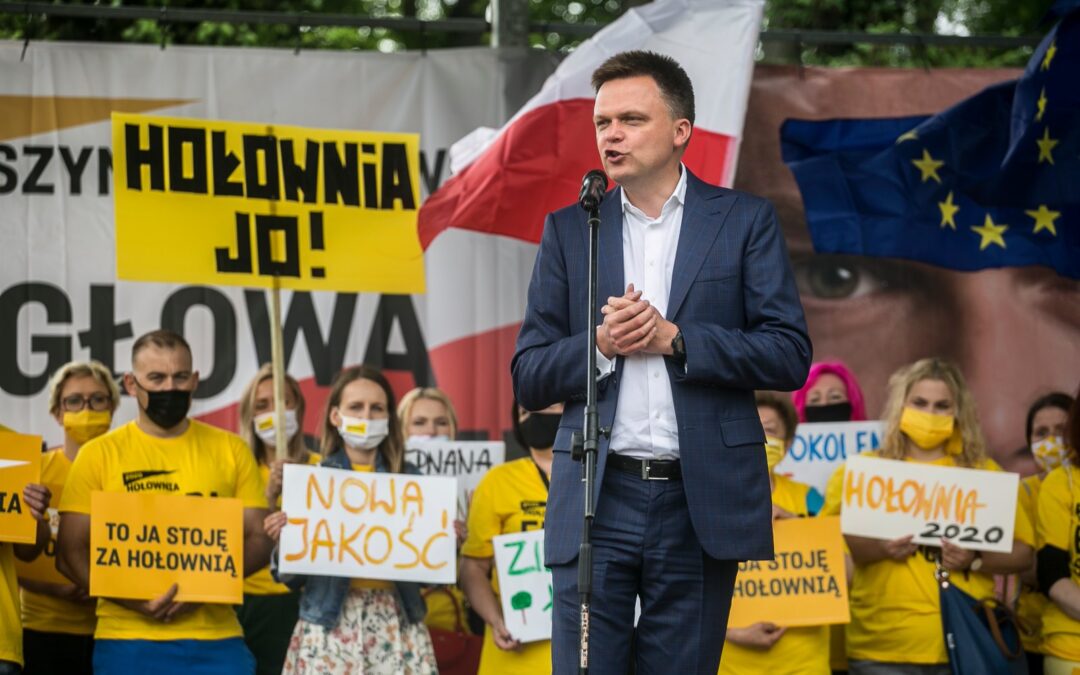By Aleks Szczerbiak
A TV presenter who made his name as a liberal-centrist Catholic commentator and writer has launched a new opposition movement and emerged as one of Poland’s most popular politicians after finishing a strong third in last summer’s presidential election.
But when the coronavirus pandemic crisis recedes and “normal” politics starts to resume, he will face more intense questioning about his lack of governing experience, programmatic vagueness and views on controversial issues such as abortion.
Poland’s most popular politician?
Szymon Hołownia – a TV presenter, writer and humanitarian activist known for his liberal-centrist Catholic views – stood as an independent candidate in last summer’s Polish presidential election. Although Hołownia’s campaign was very professionally managed – and his programme contained an eye-catching mix of policies focusing on environmental protection, national security, social solidarity, healthcare and raising standards in public life – it developed little traction until the coronavirus pandemic crisis turned conventional politics on its head.
By precipitating a shift from traditional campaigning – where local grassroots organisation, financial resources, and access to the traditional media favoured candidates from the more established parties – to political communication primarily through the internet and social media, the crisis played to Hołownia’s strengths as a skilled direct-to-camera performer. Making an attractive pitch to the many Poles who craved a “new” non-party candidate, Hołownia finished a strong third, securing 13.9% of the votes.
Hołownia used his presidential election success as a springboard to launch a new movement: Poland 2050 (Polska 2050), whose name is meant to indicate a political vision spanning more than one generation. Opinion polls suggest that Hołownia is now one of Poland’s most popular and trusted politicians; in some rankings he actually comes in first.
At the end of February, the “Ewybory” website that aggregates voting intention surveys also found support for Poland 2050 running at 18%, compared with 19% for the liberal-centrist Civic Platform (PO) – Poland’s governing party between 2007 and 2015, and currently the main parliamentary opposition grouping – and 33% for Law and Justice (PiS), the country’s right-wing ruling party.
Last month, Poland 2050 also established its own parliamentary caucus as three MPs and one senator from other parties – including Joanna Mucha, a one-time PO minister and party leadership contender – switched allegiance to Hołownia’s grouping.
Deliberate programmatic vagueness?
Not only does there appear to be an appetite for the kind of ‘newness’ that Hołownia claims to represent, Poland 2050 seems to be much more professionalised and carefully planned than previous attempts to develop Polish “challenger” parties. His years of TV experience have made Hołownia a very effective communicator in both the traditional and new media, and he is skilled at avoiding the gaffes that have often sunk other political newcomers.
Moreover, the fact that Hołownia is not a member of parliament, and his party only has a minimal presence there, means that he can present himself as above the day-to-day-political fray and choose carefully when and how to insert himself into Polish political debates.
Up until now, Hołownia’s appeal has also been ideologically eclectic and avoided too many programmatic specifics. So, for example, although he was known to hold relatively conservative views on moral-cultural questions, Hołownia has tried to downplay this by prioritising issues traditionally identified with the political left, such as adopting a more radical approach to climate policy.
This (arguably deliberate) programmatic vagueness has helped Hołownia avoid alienating potential voters without appearing to depart too far from his previous declared beliefs, and allowed a very wide range of Poles to “project” their own views onto the Poland 2050 leader.
This is important because Hołownia has the greatest potential for expanding his electoral base among younger, more culturally liberal and increasingly secular Poles who comprise the obvious core constituency for any liberal or left-wing Polish challenger party.
Hołownia has tried to counter the fact that he originally made his name as a Catholic commentator and writer by making Poland 2050’s first major programmatic statement on the need for a clearer separation between the church and state, unveiling a series of popular anti-clerical policies including: cutting state funding to church-aligned bodies; more rigorous investigation of clerical sexual abuse; reducing the clergy’s presence at state ceremonies and in public institutions; and providing greater scope for opting out of religious education in schools.
Finessing the abortion issue
Interestingly, Poland 2050 was the main beneficiary in the polls from the huge wave of street protests that followed last October’s constitutional tribunal ruling – invalidating a provision in the 1993 abortion law allowing termination of pregnancy in cases where the foetus was seriously malformed or suffered from an incurable disorder – which mobilised many younger Poles.
This was in spite of the fact that Hołownia was known to be a supporter of the, already very restrictive, current abortion law, while the protests were led by radical left-wing feminists who favoured its liberalisation.
Hołownia tried to finesse this by saying that, although he remained personally opposed to abortion, as a politician he had to take into account those who held different views. He argued that, given that the two sides of the debate were now so polarised, the issue could only be resolved by a national referendum.
Hołownia was thus able to position himself as broadly sympathetic to the protestors without doing a complete volte-face on his previous, unambiguously anti-abortion statements, or cutting himself off from the political centre ground, which still appears to broadly favour the 1993 law as an acceptable compromise and opposes attempts to both liberalise it and make it more restrictive.
Hołownia is also benefiting from the relative weakness of the other opposition groupings, especially PO, which has failed to develop a convincing programmatic alternative to PiS on the socio-economic issues that Poles care most about, and lacks strong and effective leadership. A January-February poll by the Social Changes agency found that only 1% of respondents saw PO leader Borys Budka as a convincing opposition leader, compared with 18% who cited Hołownia.
Popular PO Warsaw mayor Rafał Trzaskowski (who scored 12% in this survey) has been bogged down with running the capital and failed to build on his success in last year’s presidential election, when he came within two percentage points of defeating PO-backed incumbent Andrzej Duda.
Political marketing or policy substance?
Nonetheless, Hołownia still faces a number of formidable obstacles and challenges. Although PO is currently at a low ebb, it has seen off powerful challenges for the mantle of main liberal-centrist opposition grouping in the past and retains considerable organisational assets.
These include: a large caucus of experienced parliamentarians; access to substantial financial resources, including state party funding; a nationwide grassroots organisational structure; and a strong local government base, including control of half of Poland’s 16 regional authorities, which play a key role in distributing EU funds and are a major source of local party patronage.
While Hołownia is still benefiting from the political momentum arising from his relatively successful presidential campaign, there are no national polls scheduled now until 2023, and it will be difficult for him to maintain public and media interest in his project. Previous successful Polish challenger parties were formed in the run-up to parliamentary elections so that they could capitalise on their “newness”.
Moreover, although Poland 2050’s ideological flexibility and lack of programmatic clarity have been effective ways of attracting and mobilising a very diverse of group of supporters – and Hołownia’s media savviness has helped him to avoid bear traps on controversial and divisive issues – it will be difficult to keep this up for two and a half years until the next scheduled elections.
To really break through in a sustainable way, Hołownia will need to go beyond being simply an articulate critic of the government and PiS-PO duopoly and be seen to be offering something genuinely new. For sure, Hołownia has tried to respond to criticisms that his movement lacks programmatic depth. He has set up a think tank, the Strategy 2050 Institute (Instytut Strategia 2050), to provide Poland 2050 with some intellectual ballast.
He is also organising a series of events where he will flesh out his programme, with policy statements promised on healthcare and the environment to follow up the one on church-state relations.
However, there is still a sense that Hołownia lacks a clear vision or big idea and that his programmatic offensive is being driven as much, if not more, by political marketing than substantive policy concerns.
Experience or generational change?
Moreover, given that the socio-economic effects of the coronavirus pandemic are likely to be felt for some time even after the current public health crisis subsides, by the next election Poles may well be looking for leaders with governing experience rather than political novices. The fact that Poland 2050 currently lacks such notable figures could be a problem if Hołownia needs to demonstrate that his movement is not just a clever political marketing creation built around another protest politician.
The defection of experienced, high-profile politicians from other parties, such as Mucha, could help to counter this, although, of course, most Poles will continue to view Poland 2050 primarily through the lens of Hołownia’s statements and actions.
Indeed, because a key reason why he attracted support in the first place was Hołownia’s promise of generational change in politics, Poland 2050 cannot be too closely associated with figures from the “old guard” like Mucha. Such political “transfers” can also cause tensions among Hołownia’s original supporters; Mucha’s defection was accompanied by the resignation of the local Poland 2050 leader in Lublin, where she is a parliamentary deputy.
In fact, Hołownia is not the first charismatic individual who has tried to shake up the Polish political scene, and achieved some short-term success, in recent years. Such challenger groupings have typically received an early poll boost – notably from the kind of younger voters who often support protest politicians but do not provide a basis for long-term political consolidation – and sometimes gone on to secure parliamentary representation, before quickly disintegrating or being absorbed by one of the main parties.
An instructive recent example was that of right-wing rock star Paweł Kukiz who, standing as an independent “anti-system” candidate, secured 20% of the votes in the 2015 presidential election. Although his Kukiz’15 grouping emerged as the third largest following the parliamentary election later that year, it only secured 9% support and within four years he was forced to stand on another party’s slate to secure re-election for himself and his closest political allies.
A product of “virtual” politics?
It is difficult to know whether Hołownia has what it takes to get through the long march to the next elections. The political situation in Poland is in flux at the moment and likely to change significantly when the pandemic crisis starts to recede and more “normal” politics returns. In spite of his high media profile, Hołownia remains an unknown quantity for many Poles, and the opinions that they have formed to date are often likely to be based on them simply projecting their own views on to him.
Although the public could be looking for “new faces” outside of the existing political elites, concerns will be raised about Hołownia’s lack of governing experience, and he will also start to face more intense questioning about his programme and views on controversial and divisive issues. It is easier to contest a personality-based presidential election as a media celebrity; in a parliamentary poll he will need to be much clearer about whom he is appealing to and with what programme.
It remains to be seen how effective Hołownia’s internet-based communications strategy will be when political debate shifts back from the “virtual” to the real world.
Main image credit: Polska 2050/Facebook





















